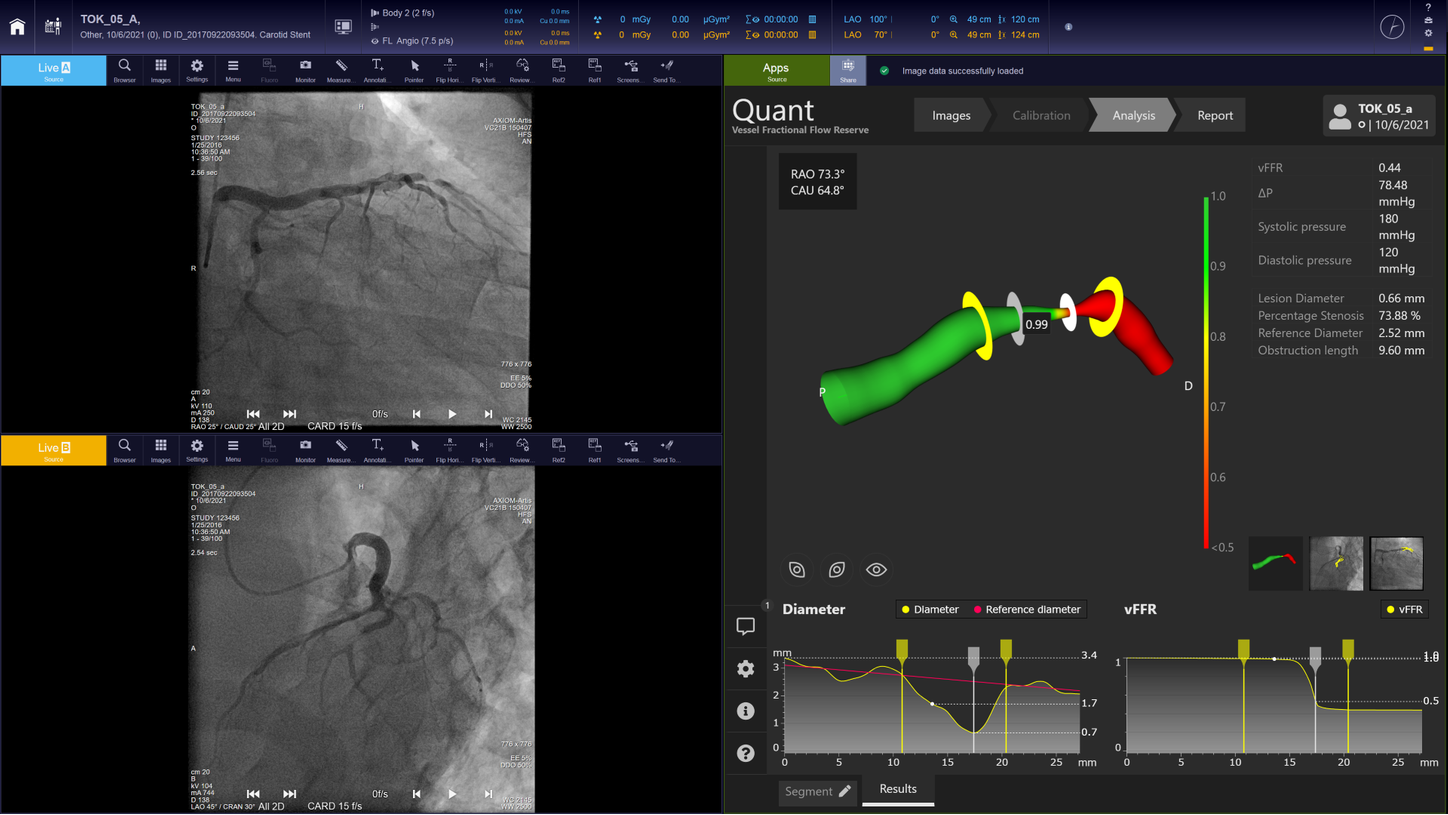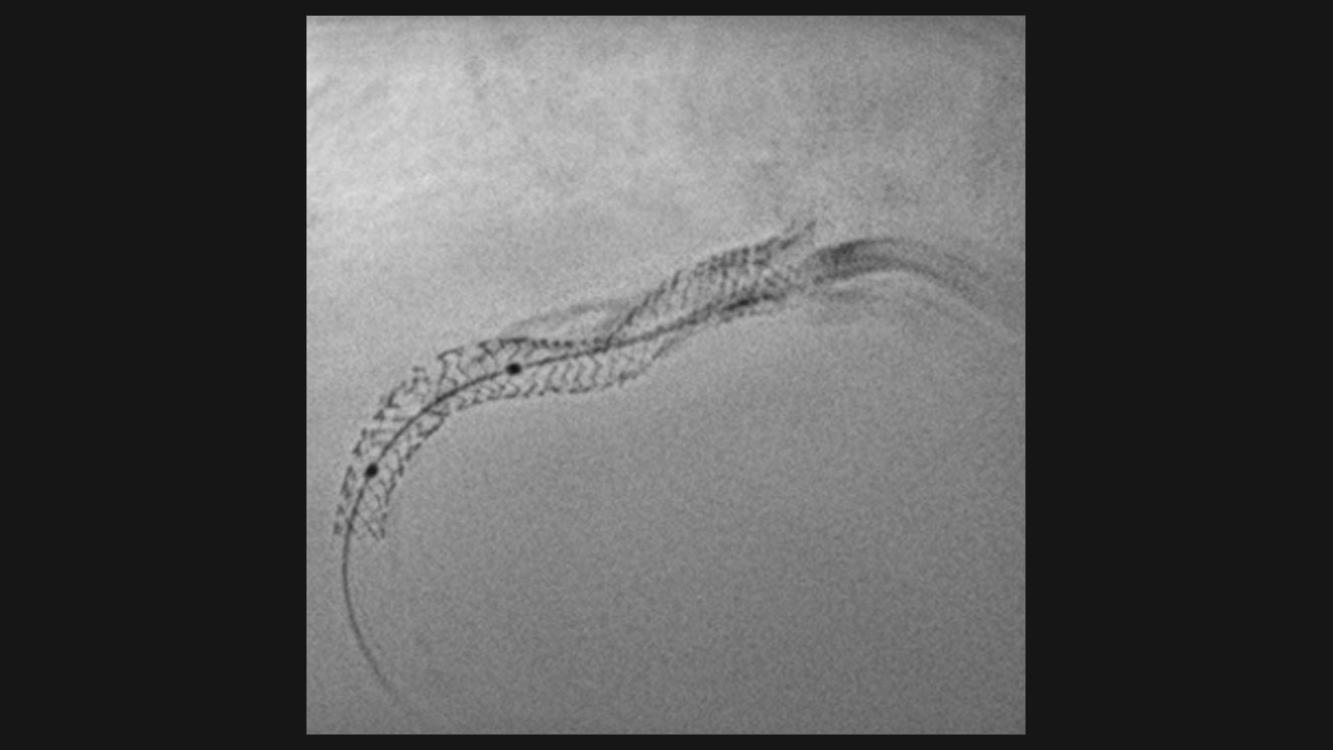- Home
- Clinical Fields
- Cardiovascular Care
- Coronary Artery Disease

Coronary Artery Disease
Enhance diagnostic confidence and therapeutic efficiency
Our vision
Coronary artery disease (CAD) demands effective and workflow-optimized interventions. With our comprehensive portfolio along the clinical pathway including point-of-care testing, lab testing, diagnostic imaging, therapy solutions and connected digital solutions we innovate the CAD pathway, helping to prevent unnecessary invasive procedures and improving precision-medicine for patients. We enable physicians with solutions to optimally diagnose and treat coronary artery disease.
Customer experience
Watch coronary artery cases and learn from your peers
Learn from the expert how we at Siemens Healthineers can support you in your daily routine.
Integration of ARTIS icono and AVVIGO+
Johannes Rigger, MD, Head of Interventional Cardiology at Kantonsspital St. Gallen, Switzerland, discusses the benefits of intravascular ultrasound (iBus) technology, highlighting its ease of use, high-resolution imaging, and AI support.
Non-invasive testing can help prevent unnecessary invasive procedures for CAD patients
Karolina Dorniak, MD, and Katarzyna Sienkiewicz, MD, from the Medical University of Gdańsk discuss the latest trends in noninvasive imaging. Many of their CAD patients are diagnosed using noninvasive cardiac CT and MRI scans.
Optimizing coronary artery patient care
At CCB in Frankfurt am Main, Professors Thomas Voigtlaender, MD, and Axel Schmermund, MD, talk about the importance of personalized care and the usefulness of image-guided noninvasive diagnosis in coronary artery disease.
How CT imaging capture the rhythm of the human heart?
Coronary artery disease is a a major cause of mortality. New guidelines recommend cardiac CT as frontline testing for coronary artery disease. Listen to how Alexandros Kallifatidis, MD, a radiologist at St. Luke's Hospital in Thessaloniki, Greece, captures heartbeat and rhythm to diagnose patients.
What is the role of cardiac MRI in diagnosing myocardial injury in long COVID-19 syndrome?
Myocardial injury has been observed as a complication of the COVID-19 disease and is associated with a poorer prognosis. Cardiac MRI (CMR) is the preferred imaging modality for the noninvasive evaluation of acute myocarditis. Watch the video of Professor Puntmann, MD, to learn more about the value of CMR in evaluating post-COVID-19 patients with cardiac disease.
How a point-of-care high-sensitivity troponin test could change myocardial infarction detection
Imagine if there was a point-of-care solution for high-sensitivity cardiac troponin assays. In this interview, Professor Louise Cullen, an emergency physician in a major metropolitan teaching hospital in Brisbane, Australia, shares her thoughts on how such a technology could change patient care for those with suspected acute myocardial infarction, and the potential benefits it could bring to emergency department efficiency.
Rapid diagnostic algorithm for faster diagnosis of acute coronary syndromes
Rick Body, MD, describes the development and implementation of a rapid diagnostic algorithm for acute coronary syndromes, the Troponin-only Manchester Acute Coronary Syndromes (T-MACS) decision aid, and how it is helping to reduce unnecessary hospitalization of low-risk patients. Hear how high-sensitivity troponin assays play a vital role in the method, enabling medical professionals to make faster decisions about patient care.
Intelligent cardiac CT
Peter Brader, MD, Diagnostikum Linz, explains the value of CT imaging in cardiac diagnostics: It's fast, easy, and efficient, and provides the patients with a better experience.
Discover the latest online webinars on demand
Listen to our customers in our online webinars series or watch our customer stories.
Novel insights into MINOCA and INOCA: Resolving diagnostic dilemmas
The complexities of diagnosing MINOCA and INOCA remain challenging. The CVC online webinar will highlight the added value of CMR, CT, and angio imaging in both acute and chronic ischemia without obstructive coronary arteries. Learn from experts Chiara Bucciarelli-Ducci, MD, and Colin Berry, MD, about the potential of diagnostic imaging for risk assessment and prognosis in MINOCA and INOCA patients.
Successfully implementing high-sensitivity cardiac troponin
Join Professor Fred Apple and Nicholas Mills as they explain the diagnostic strategies for using a high-sensitivity cardiac troponin assay and review evidence-based literature that supports implementation of high-sensitivity troponin testing in clinical practice. Profsessor Apple and Mills will also discuss the latest ESC and NICE guidelines and how these recommendations impact their interpretation perspectives.
What is the optimal approach to stratify risk and investigate patients after myocardial infarction has been ruled out?
Watch our CVC webinar and get insights from the experts Michelle Williams, MD, and Prof. Nicolas Mills, MD into troponin-guided Coronary Computed Tomographic Angiography after exclusion of myocardial infarction.
Acute chest pain management for NSTE-ACS patients
The recently released 2021 US guidelines for evaluation and diagnosis of chest pain recommend high-sensitivity cardiac troponins as the preferred standard for diagnosis of acute myocardial infarction. Furthermore, coronary CTA is recommended as a frontline testing strategy in the evaluation of patients with stable and acute chest pain who have no known coronary artery disease. In this context, we are offering an online webinar on "the role of CCTA in triage patients with acute chest pain in the era of high-sensitivity troponin." Join our ESC satellite online webinar with James Januzzi, MD, Koen Nieman, MD, and Markus Scherer, MD.
The present and future of vFFR
This online webinar was all about the present and future of vFFR, introducing clinical validation, live cases, and future outlook. Experts Joost Daemen, MD, Professor Eric van Belle, MD, and Kaneshka Masdjedi, MD, discussed the role of angiography-derived physiology CAAS vFFR, how it works, and how you can implement vFFR in your cath lab. Join a live case and experience how pre- and post-PCI vFFR measurement can help in clinical practice. Get more insights into the FAST study validation series and the outcomes of the recently published FAST II multicenter study.
Physiological assessment of lesions after PCI: The new routine?
In the second installment of our Cardiovascular Care online webinar series, a lineup of experts in the field of coronary physiology discussed how the use of post-PCI physiology can improve patient outcomes. Chairman Bernard De Bruyne, MD, was joined by Joost Daemen, MD and Simone Biscaglia, MD, to debate why, despite unequivocal evidence supporting its use, adoption of post-PCI physiology assessment into routine practice is still limited.
The new reality: Complex coronary intervention in virtual patients
Our new online webinar series started with a great lineup of leading experts in the field of cardiovascular care. Stephan Achenbach, MD, chaired the first online seminar. Here, the experts discussed the current state of interventional education in Europe and what simulation brings to that.
Patient stories
Coronary artery disease (CAD) is the most common type of heart disease.1 While age can be a risk factor, coronary artery disease does not only affect old people. Younger people can also have a heart attack.
Frank, an athletic 50-year-old man, went for a cardio checkup at the request of a friend. Learn how his friend saved him from a heart attack.
Bruno, a healthy and athletic 56-year-old man with no history of heart disease has a heart attack after a routine workout. Watch his story.
Frank, an athletic 50-year-old man, went for a cardio checkup at the request of a friend. Learn how his friend saved him from a heart attack.
Bruno, a healthy and athletic 56-year-old man with no history of heart disease has a heart attack after a routine workout. Watch his story.
Frank, an athletic 50-year-old man, went for a cardio checkup at the request of a friend. Learn how his friend saved him from a heart attack.
Our product and solutions portfolio
Experience the latest technologies in our coronary artery disease product portfolio

NAEOTOM Alpha
with Quantum Technology
NAEOTOM Alpha® offers high resolution in cardiac imaging to
- see small details in coronary CTA;
- identify more details in coronary plaque evaluation;
- offer high resolution at low dose in all standard CT angiography protocols.

Atellica VTLi Patient-side Immunoassay Analyzer
Attelica® VTLi Immunoassay Analyzer represents a vital leap forward in cardiac testing and
- improves emergency department throughput;
- offers hs-cTnI testing right at the point of care;
- can be easily integrated into assessment processes.
ARTIS icono
An icon of innovation
Turn innovation into common practice with
- excellent coverage with a small footprint;
- the new image chain, OPTIQ, enabling significant dose reductions;
- Structure Scout, offering material-specific imaging.

QuantWeb vFFR
Integration of angio-based FFR
Courtesy of University of Tokyo Hospital, Japan
Less invasive angio-based FFR calculation tool vFFR
- calculates the pressure drop in the coronary arteries;
- is a fast and easy-to-use tool to assess the hemodynamic relevance of stenoses;
- shows high correlation with FFR and high inter-observer reproducibility.

syngo CTO Guidance
Preprocedural planning using CT data
Courtesy of LMU Klinikum Munich, Germany
Expand your procedure mix by treating more CTO patients using syngo CTO Guidance for
- automated segmentation of the coronaries, centerline extraction, and color coding of the centerlines to indicate foreshortening;
- preprocedural planning of optimal angulations;
- shorter wiring times2
- reduced fluoroscopy duration2

ClearStent Live
Real-time stent enhancement
Courtesy of Universitätsklinikum Erlangen, Germany
ClearStent Live allowing real-time verification of stent positioning while moving the device
- is integrated into the ARTIS systems, without the need of an additional workstation;
- supports complex procedures like kissing stents, skirting technique, and adjacent stents;
- offers the potential to speed up procedures and save contrast agent.
Make successful business cases your own

CTO Guidance Calculator
Learn how you can make the most of your investment

ClearStent Live Calculator
Learn how to make the most of your investment
Did this information help you?
Thank you.
European markets for heart valve devices 2010, Millennium Research Group
Prevalence model by SHS AT CVC BD based on: [1] Durko et. al (2018), [2] Nkomo et al. (2006), [3] Population data US and Europe, DGR (2019), and Global Data (2019)



